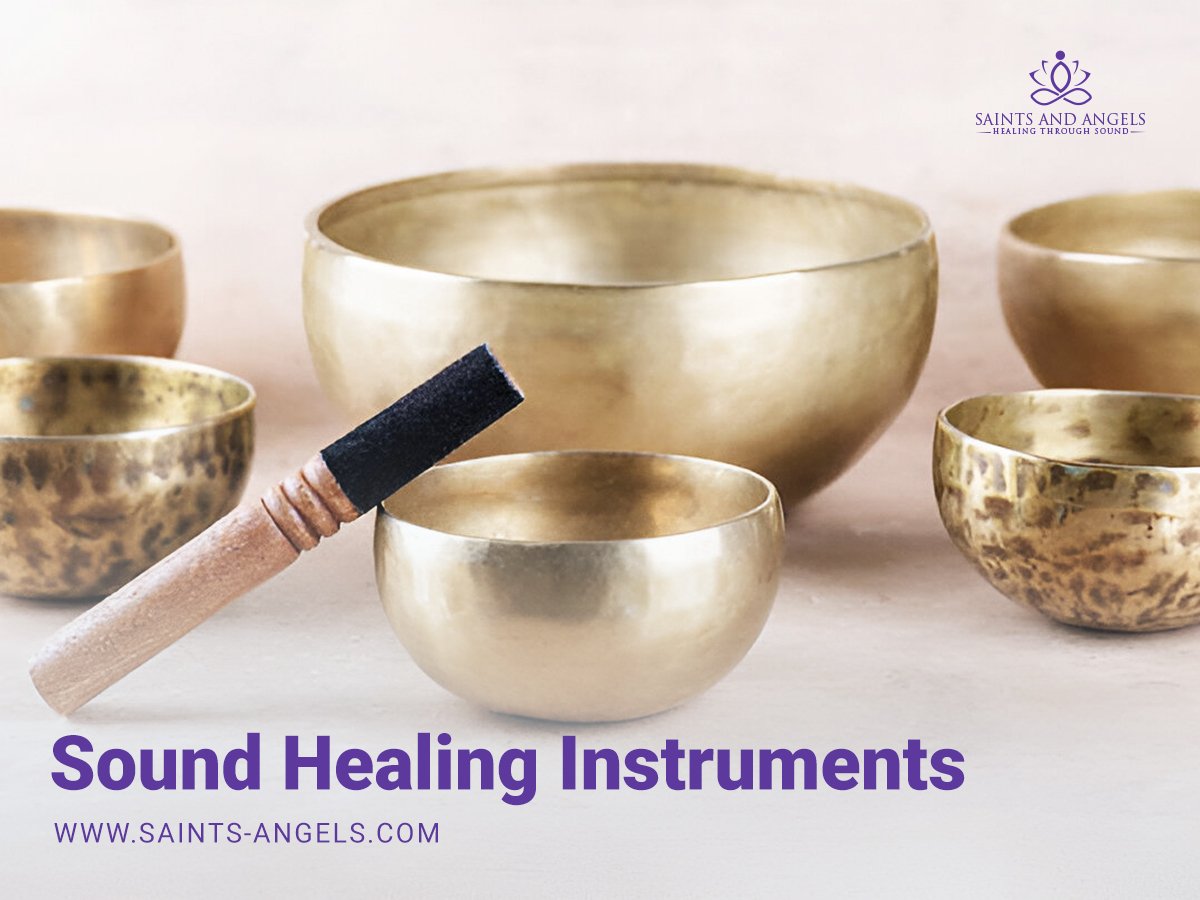Sound healing, an ancient practice that provides a pathway to relaxation and physical healing, has steadily gained recognition for its effectiveness in calming the nervous system, reducing anxiety, and enhancing overall well-being. At the heart of this therapeutic journey are crystal singing bowls, remarkable instruments that have transformed countless lives by clearing energy blockages and bringing balance to the mind, body, and soul. As we delve into the world of sound healing training, we explore the potent healing powers of sound baths and crystal bowls, techniques that have provided relief and tranquility for centuries across the globe.
Our journey through this article will introduce you to the essentials of sound bowl training, from the rich history and science behind crystal singing bowls to practical guidance on how to use a sound bowl, creating immersive healing sessions, and mastering advanced playing techniques. Whether you’re looking forward to enrolling in a sound healing workshop, eager to host your sound bath class, or simply curious about enhancing your practice, this piece serves as your gateway to mastering sound healing training near me and becoming a proficient sound healing practitioner.
The Science and History of crystal singing bowl training
Crystal singing bowls, intriguing instruments in the realm of sound healing, have a relatively modern origin tied intricately to technological advancements. Initially a byproduct of the computer industry, these bowls were crafted from pure silicon quartz, intended for the growth of silicon chips. This innovative use of quartz crystal reflects a fascinating intersection between technology and wellness, showcasing how materials intended for industrial purposes can find profound applications in healing and meditation.
Origins and Evolution
- Initial Development: The first crystal singing bowl emerged in the 1980s, crafted from 99.8% silicon quartz. This material was used in the computer industry to create crucibles that held molten silicon for chip manufacturing.
- Manufacturing Process: These bowls are made by placing granulated quartz and sand in a spinning mold, which is then heated to approximately 4000 degrees Fahrenheit. This process melds the quartz and sand into a solid, smooth bowl without the crystalline structure of natural quartz.
Comparison with Traditional Tibetan Singing Bowls
- Material Differences: Unlike crystal singing bowls made from silicon quartz, traditional Tibetan singing bowls utilized a five-metal alloy known as panchaloga. This blend often included metals like gold, silver, and copper, which were believed to provide unique vibrational benefits.
- Sound and Healing: Quartz crystal bowls are prized for their ability to produce a very pure, resonant tone that aligns closely with the chakras, making them ideal for meditation and sound therapy.
Technological Advancements in Bowl Production
- Modern Techniques: The complexity of creating Sound Healing bowls involves advanced manufacturing techniques capable of handling high temperatures and precise conditions to maintain the purity of the quartz.
- Tuning and Customization: Post-manufacture, the bowls are often tuned in the United States. The tuning process ensures that each bowl resonates at a specific frequency, which can correspond to different musical notes or chakra alignments.
Unique Properties of Crystal Singing Bowls
- Electromagnetic Effects: During use, the quartz in the bowls helps to balance the electromagnetic field around the user, enhancing the meditative and healing experience.
- Chakra Alignment: The clear quartz bowls are often associated with the seven chakras, each represented by one of the rainbow colors visible in the bowl under certain light conditions. This visual and auditory stimulation is said to activate and balance the body’s energy centers.
Global Production Insights
- Primary Production Locations: While many crystal singing bowl are marketed as being made in the USA, the majority of the silica sand used originates from China. The bowls are shaped and initially formed in China or Korea before being shipped to the U.S. for finishing processes like tuning and sometimes additional aesthetic enhancements.
- Innovations in Bowl Design: Some manufacturers have begun incorporating fused mineral powders into the bowls, adding vibrant colors and additional energetic properties to the instruments. These enhancements are carefully managed to maintain the bowl’s sound quality.
The integration of crystal singing bowls into sound healing practices represents a perfect blend of ancient tradition and modern innovation. By understanding both the scientific and historical aspects of these instruments, practitioners and enthusiasts can deepen their appreciation and enhance their use of crystal singing bowls in therapeutic settings.
Playing Techniques for Beginners
Setting Up Your Space and Intentions
Before diving into the techniques of playing crystal singing bowls, it’s crucial to prepare both your physical space and mental state. This preparation enhances the effectiveness of your practice, whether it’s for personal meditation or a sound healing session.
- Find a Quiet Space: Ensure the area is free from disturbances to maintain focus and clarity during your session.
- Position the Bowls Properly: Place the crystal singing bowls on a flat surface equipped with o-rings to stabilize them. For beginners, positioning the bowls in front of you allows for easier observation and access.
- Set Your Intentions: Clear intentions guide the energy of your session, aligning it with your goals for healing or relaxation.
Basic Techniques for Playing the Bowl
Learning to play crystal singing bowls involves mastering a few fundamental techniques that allow for the creation of resonant and healing sounds.
- The Gong Beat Technique:
- Method: Gently tap the rim, side, or inner walls of the bowl with a mallet.
- Outcome: Produces healing sounds with minimal effort, ideal for beginners.
- Circular Motion Singing:
- Method: Circle the tip of the mallet over the rim, sides, or inner walls continuously.
- Effect: Creates a continuous, resonant sound that enhances the meditative quality of the session.
Advanced Handling and Sound Control
As you become more comfortable with the basic techniques, refining your control over the bowl’s sound will deepen the therapeutic effects.
- Mallet Handling:
- Grip: Hold the mallet like a pencil, using a firm grasp with the thumb supporting the bottom.
- Angle: Adjust the angle of the mallet based on its type; suede mallets should be angled away from the bowl, while rubber mallets should angle towards it.
- Sound Dynamics:
- Contact Point: Maintain contact approximately two inches below the rim for consistent sound production.
- Movement: Start by chiming the bowl lightly, then gradually move around the bowl to create sound. Control the volume by adjusting the speed of movement—faster for louder sounds and slower for softer ones.
Practice and Sensitivity
Developing proficiency with crystal singing bowls is an ongoing process that requires regular practice and a sensitive ear.
- One-Hand Practice:
- Technique: Begin by using one hand at a time to focus on the quality of the sound and your control over the bowl.
- Progression: As you gain comfort, try alternating hands to build skill and coordination.
- Listening and Adjusting:
- Focus: Be acutely aware of the sounds you produce, aiming for a sweet, harmonious tone that contributes to a calming atmosphere.
- Adjustments: If the sound becomes too loud or dissonant, pause or remove the mallet to reset.
Bowing Technique
For those looking to explore different sound textures, the bowing technique offers a unique approach similar to playing string instruments.
- Execution: Perform a back-and-forth motion with the wand, akin to bowing a violin, to gradually build the sound. This method requires patience and gentle handling to maintain the crystal bowl’s integrity and sound quality.
By following these guidelines and regularly practicing, beginners can effectively harness the therapeutic powers of crystal singing bowls, enhancing both personal and professional healing practices.
Advanced Playing Techniques
Water Charging with Crystal Singing Bowls
Water charging is a unique technique that enhances the energetic properties of water through the vibrations of crystal singing bowls. Here’s how to practice this technique:
- Filling the Bowl: Add water to your crystal singing bowls until it is half full.
- Playing the Bowl: Use a mallet to rim the bowl continuously for long intervals, allowing the vibrations to charge the water.
- Usage: The charged water can then be used for anointing, consecration, or clearing spaces, carrying the bowl’s energy.
Dual Mallet Techniques for Enhanced Sound
Playing a crystal singing bowls with both hands can create a more complex and layered sound. This technique requires flexibility and a deeper understanding of the bowl’s responses:
- Mallet Positioning: Hold a mallet in each hand.
- Simultaneous Play: Use both mallets to play the same bowl at different points.
- Sound Layering: Experiment with varying pressures and speeds to layer sounds effectively.
Playing Multiple Bowls
Creating a symphony with multiple crystal singing bowls can produce harmonies and new tones that are profoundly healing:
- Bowl Arrangement: Position the bowls in a circular, semi-circular, triangular, or rectilinear pattern around you.
- Coordinated Playing: Strike or rim the bowls in a sequence that creates a harmonious sound flow.
- Exploring Harmonies: Listen for the interaction between different tones and adjust your playing technique to enhance the harmony.
The WAH-WAH Technique
This advanced technique involves using your breath in conjunction with the sound of the bowl:
- Initial Sound Generation: Tap or rim the bowl to start the sound.
- Chanting While Playing: As the bowl sings, bring it close to your mouth and chant, modulating your breath to interact with the sound waves.
- Sound Modulation: Move the bowl away from and towards your mouth to create a wah-wah effect with the sound.
Creating Chords and Melodies
Understanding musical intervals and chords can elevate your sound healing sessions by introducing familiar and comforting harmonies:
- Chord Creation: Play bowls tuned to specific musical notes together to form chords. For example, playing C, E, and G together forms a C major chord.
- Progressions: Alternate between different bowls to create a progression, such as playing C and G, then C and E, and back to C and G.
- Rhythmic Patterns: Strike the bowls in a rhythmic pattern or maintain a consistent rhythm by striking the same bowl in the same order to create a melody.
Advanced Bowing Techniques
Similar to string instruments, you can use a bow on crystal singing bowls for a continuous, ethereal sound:
- Bowing Method: Use a bow to make continuous contact with the bowl’s rim, applying even pressure and speed to maintain the sound.
- Sound Texture: Experiment with different pressures and speeds to vary the sound texture, creating dynamic soundscapes during your sessions.
These advanced techniques in playing crystal singing bowls require practice and sensitivity to the subtle energies of the bowls. By mastering these methods, you can deepen your sound healing practice and provide more profound healing experiences for yourself and others.
Creating a Healing Sound Bath
Preparing Your Space and Instruments
- Space Cleansing: Begin by cleansing your space to ensure it is free from distractions and conducive to relaxation. This can be done using sage, palo santo, or your preferred method of space clearing.
- Setting Intentions: Before starting the sound bath, hold your crystal singing bowl and set a clear intention for the healing session. This could be for relaxation, energy alignment, or emotional release.
- Bowl Arrangement: Arrange your crystal singing bowls in one of the following configurations based on your session goals:
- Chakra Order: Align the bowls according to the chakra colors and notes, ideal for energy center balancing.
- Musical Note Order: Set them up by size for intuitive play.
- Harmony Sequence: Place them to achieve specific harmonies, like D-F-A on one side and C-E-G on the other.
- Full Octave: Include all notes from C to C, incorporating the Soul Star bowl for a complete octave.
Conducting the Sound Bath
- Instrument Selection: Choose your instruments wisely. For a focus on crystal singing bowls, complement them with frame drums for bass notes and possibly a harmonium for continuous drone sounds.
- Participant Setup: Ensure all participants are comfortably positioned, often in restorative yoga poses, to facilitate relaxation and the full benefits of the sound bath.
- Playing Techniques:
- Initial Strike: Gently strike the edge of a bowl with a mallet to start the resonance.
- Continuous Play: Continue by playing the rim of the bowl to maintain and extend the sound waves.
- Intuitive Interaction: Feel free to play the bowls around their rims or strike them intermittently, following the rhythm that feels most harmonious and soothing.
Enhancing the Experience
- Dynamic Sound Layering: Use multiple bowls to create a symphony of sounds, adjusting your technique to layer the vibrations effectively.
- Incorporating Additional Instruments:
- Frame Drums: Add depth with the consistent beat of a large frame drum.
- Shakers and Chimes: Introduce higher harmonies with shakers and chimes to enrich the sound bath’s texture.
- Vocal Integration: If appropriate, use vocal toning or chanting to add a personal vibrational touch that enhances the healing environment.
Maintaining Flow and Focus
- Rhythmic Consistency: Maintain a slow, steady rhythm with the bowls, which helps in calming the mind and deepening the meditative state of the participants.
- Mindful Silence: After the final sounds fade, hold a moment of silence, allowing participants to internalize the experience and focus on their breath.
- Closing Ritual: End the session by cleansing your instruments and space once again, and encourage participants to remain in a state of gratitude as they transition back to their day.
By carefully selecting your instruments, setting up your space, and guiding the sound bath with intention and sensitivity, you can create a profoundly relaxing and healing experience for all participants.
Integrating Chakras and Sound Healing
In the realm of sound healing, the seven chakras are integral energy centers located along the spine, each corresponding to different aspects of our physical, emotional, and spiritual well-being. We can effectively balance these chakras using various sound healing techniques, including singing bowls, chanting, and Bija mantras. Here’s how we can integrate these practices into our daily routine to enhance our overall health and harmony.
Understanding the 7 Chakras and Their Correspondences
The chakras, from the root to the crown, each have unique vibrations and are associated with specific aspects of our health and consciousness. By targeting these energy centers with specific sounds, we can promote balance and healing.
Techniques for Chakra Balancing Using Sound
- Singing Bowls: Each bowl is tuned to resonate with the frequencies of a particular chakra. Playing a bowl that corresponds to a blocked or unbalanced chakra can help in aligning and energizing it.
- Chanting and Bija Mantras: These are sounds that resonate with the energies of the chakras. Chanting these mantras helps in clearing blockages and enhancing the flow of energy.
- Vocal Toning: This involves using vowel sounds to direct healing vibrations to different chakras. Each vowel sound corresponds to a specific chakra, aiding in its activation and balancing.
Daily Practice of Vocal Toning
Incorporating vocal toning into your daily routine is a simple and effective way to maintain chakra health. It’s a technique that requires no special tools and can be done anywhere, making it a versatile addition to your wellness practices.
Technique Introduction by Becky Cresswell: Birmingham-based teacher, Becky Cresswell, offers guidance on simple vocal toning techniques using vowel sounds. These sounds help direct the healing vibrations to specific chakras, promoting balance and wellness.
Step-by-Step Guide to Integrating Sound Healing in Daily Life
- Finding a Comfortable Position: Begin by finding a quiet and comfortable place where you won’t be disturbed. This could be a dedicated meditation space or any place where you can sit or lie down comfortably.
- Clearing Your Mind: Take a few deep breaths to center yourself and clear your mind of distractions. This helps in enhancing the effectiveness of the sound healing practice.
- Chanting Your Chosen Mantra: Softly chant the Bija mantra or vowel sound associated with the chakra you wish to balance. Focus on your exhale as you release the sound, visualizing the energy flowing into and harmonizing the chakra.
By understanding and applying these techniques, we can effectively integrate chakra balancing into our sound healing practice. Regular engagement with these methods not only enhances our physical and emotional health but also deepens our spiritual connections, fostering a greater sense of peace and well-being.
Self-Care and Maintenance of Your Bowls
Maintaining the pristine condition and energy of your crystal singing bowls is crucial for their longevity and effectiveness in sound healing sessions. Here’s a comprehensive guide to help you care for these delicate instruments properly.
Cleaning Techniques
- Routine Cleaning:
- Materials: Use distilled water, optionally mixed with a 10% solution of mild detergent.
- Method: Wash the bowl gently using the solution, then rinse with clear water.
- Drying: Dry thoroughly with a blow dryer to prevent water spots.
- Deep Cleaning for Frosted Bowls:
- Materials: Small handheld steam cleaner.
- Method: Apply steam carefully to remove stubborn stains without chemical residues.
- Natural Cleaning Options:
- Materials: Natural rainwater is preferred for its purity.
- Method: Gently wipe the outer surface of the bowl towards yourself to avoid slipping.
Preventative Measures
- Vibration Absorption: Place a soft fabric at the bottom of the bowl when using a crystal stone or puck light to absorb excess vibrations and prevent cracking.
- Rubber Support: Always use a rubber ring under the bowl during play to enhance stability and prevent damage.
- Temperature Caution: Avoid exposing your bowls to extreme temperatures which can cause cracking or weakening of the crystal.
Handling and Storage
- Safe Handling: Always be gentle when moving or playing your bowls to avoid accidental impacts.
- Storage Tips:
- Protection: When stacking bowls, separate them with bubble wrap, neoprene bags, or thick fabric.
- Spacing: Keep multiple bowls at least 12 inches apart to avoid collisions.
Maintenance and Longevity
- Regular Check-ups: Regularly inspect your bowls for any signs of wear or damage.
- Energy Cleansing: For energetic maintenance, soak the bowl overnight in soapy water with a pinch of salt for energy clearing.
- Professional Advice: If unsure about any damage or maintenance issue, consult a professional before attempting repairs.
Special Considerations
- Safety First: Never place a person’s head inside or too near a bowl while playing to avoid discomfort or injury.
- Membership Benefits: Join the Broken Bowl Club at the Sound Journey Store for a 15% discount on replacement bowls by saving the pieces of your broken bowl.
By following these guidelines, you can ensure that your best crystal singing bowls remain a cherished and effective tool in your crystal singing bowl training Regular care not only preserves their physical integrity but also enhances their vibrational qualities, ensuring they continue to provide healing and relaxation for years to come.
Taking Your Practice Further
Embarking on a journey through sound healing, especially with crystal singing bowls chicago, opens up a universe of possibilities not just for personal enrichment but also for empowering others. As you delve deeper into this practice, consider taking structured courses and engaging with community support to enhance your skills and understanding.
Explore Sound Healing Training Courses
Sound healing training courses in Chicago are invaluable for those looking to deepen their knowledge and practical skills with crystal singing bowls. These courses offer structured learning, from the basics to more advanced techniques, and provide a solid foundation for both personal and professional practice.
- Comprehensive Learning: Courses cover everything from the basics of playing crystal bowls to conducting full sound healing sessions in Chicago, suitable for both group settings and one-on-one client interactions.
- Professional Guidance: Experienced instructors offer insights into the unique energetic vibrations of crystal singing bowls, helping you understand how to use them to shift energy, clear blockages, and restore balance.
The Art of the Crystal Singing Bowls Program by Denise
For those seeking a more specialized approach, Denise’s ‘Art of the crystal singing bowl training program offers a progressive series of lessons that enhance your playing techniques and compositional skills.
- Lesson Structure: The program is structured in easy-to-follow stages, allowing you to master each technique at your own pace. Some techniques might be quick to learn, while others require more dedicated practice.
- Advanced Techniques: You’ll learn how to top melodies, use the bowls for grounding and expansion, and even deliver cosmic hugs to aid in healing pain and suffering.
Community Support and Continuous Learning
Joining a community, such as the Facebook group offered by Denise, provides ongoing support and a platform to share experiences and resolve queries.
- Interactive Learning: Engage with other practitioners, share your progress, and get your questions answered by both peers and mentors.
- Continuous Improvement: Regular interaction with a community helps in keeping your practice fresh and innovative, as you learn from the experiences and techniques of others.
Enrollment in the Enlightened Sound Practitioner Program
If you find joy and fulfillment in playing crystal singing bowls and wish to take your skills to a professional level, enrolling in the Enlightened Sound Practitioner program could be your next step.
- Expert Training: This program is designed to refine your techniques and expand your knowledge about creating various sound journeys.
- Certification: Completing this program not only enhances your skills but also provides you with the credentials to practice as a certified sound healing practitioner.
By advancing your practice through these structured courses and community engagements, you not only enhance your own skills but also contribute to the wider field of sound healing, promoting wellness and balance through the beautiful sounds.
Conclusion
Embarking on the journey of sound healing, particularly through the medium of crystal singing bowls, offers a profound path to personal well-being and the opportunity to facilitate healing in others. The intricate blend of history, science, and spirituality encapsulated in these instruments underscores the importance of a dedicated practice that not only respects the traditions behind them but also embraces the advancements that continue to enrich their application. By understanding the nuances of bowl selection, playing techniques, and the intricacies of sound baths, enthusiasts and practitioners alike are well-equipped to harness the transformative power of sound healing.
As this exploration of crystal singing bowls and their application in sound healing in Chicago concludes, it’s clear that the practice presents a unique confluence of art, healing, and science, offering significant benefits for mental, emotional, and physical health. Whether through the pursuit of personal harmony or the provision of healing to others, the journey with these instruments is one of continuous learning and discovery. By integrating the knowledge of chakras, advancing playing techniques, and incorporating sound healing into daily routines, individuals can deepen their practice, contributing to the collective appreciation and understanding of this ancient yet ever-evolving healing modality.





